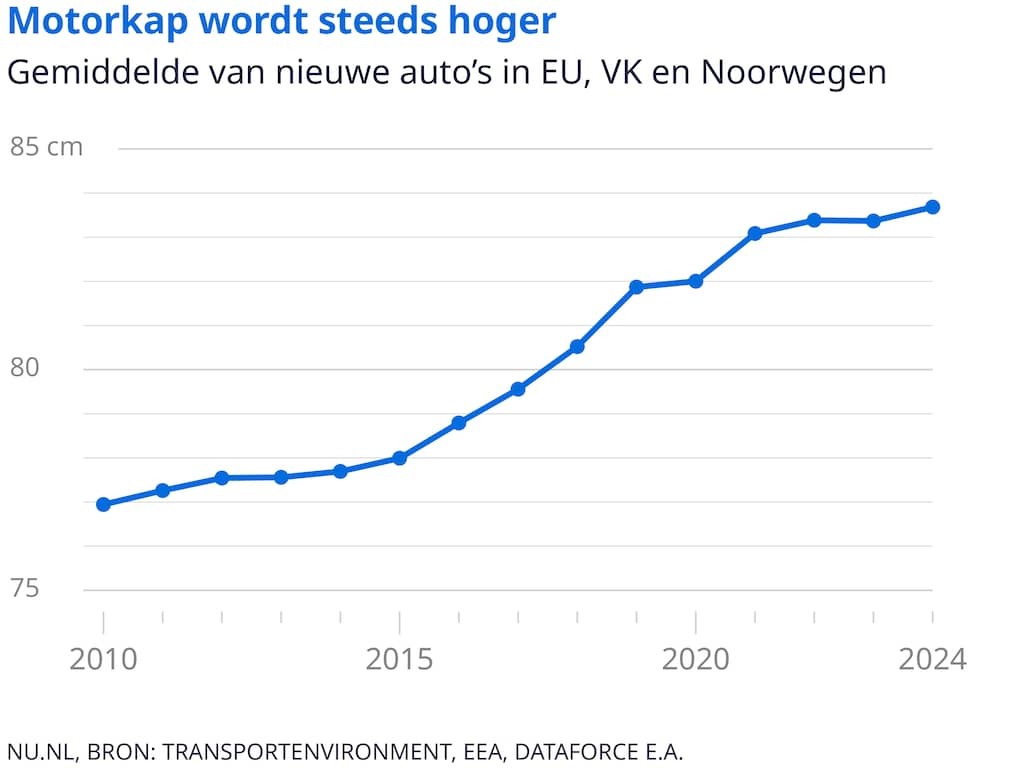
Cars are getting bigger and more luxurious. This is bad for the environment, fuel consumption, and parking. Road safety also suffers, according to new European research. Why are we increasingly buying a large SUV instead of a modest passenger car?
Cars have been growing in size since the 1990s, but this ‘autobesitas’ is increasing even faster due to the rise of the SUV (sports utility vehicle). According to a new report by the European Federation for Transport and Environment (T&E), in 2010 only 12 percent of new cars in Europe were such a large model. In 2024, that was already 56 percent.
It is actually remarkable that more than half of the new cars sold are SUVs. Because those cars were once designed to drive safely over rough terrain, instead of to the supermarket in a residential area. In the Netherlands, too, more than half of the newly registered cars are SUVs, calculated by mobility organization BOVAG.
Cars are also becoming larger on average because the consumer wants that, says Rico Luman, sector economist automotive at ING Research. “Most Dutch people want such an SUV because of the appearance, the high entry and the space. Your family and luggage can comfortably go on holiday in it and a large car makes an impression when you drive by a customer.”
Most Dutch people who take a new car lease a company car. According to Luman, they pay less attention to the costs per kilometer, which are higher for SUVs. Car manufacturers also know this, so they produce more large and luxury models.
Not only bad for the environment, but also unsafe
The love for big cars has quite a few disadvantages. Because it is not very environmentally friendly. This applies both to the construction of the vehicle and to fuel consumption. You use more gasoline, diesel or electricity if you drive a larger car.
Road safety is a new concern according to the T&E report, due to the increasingly higher engine hoods. On average, the engine hood of a new car becomes half a centimeter higher every year. Since 2010, the engine hood has grown by 7 centimeters, to a height of 83.8 centimeters, as can be seen in the graph below.

Children are therefore more difficult to see for the motorist. And the high front makes it more likely that a pedestrian will end up under the car in a collision, with potentially serious consequences.
But those who want to buy a smaller or lower car also have less to choose from at the dealer. “During the corona pandemic, the popularity of SUVs grew very quickly,” says Luman. Due to the lockdown, car sales collapsed and manufacturers focused even more on cars with a high profit margin.
Smaller models grow with SUV
The smaller models that are still there grow through for the customer. Many passenger cars take over certain characteristics of SUVs, such as the high entry with a large engine hood. This cross-pollination leads to so-called cross-overs. Nevertheless, Dutch people want to drive bigger and more often electrically, sees Willemijne de Wit, director at leasing company Athlon.
“Our ten most popular lease cars of the year are all electrically powered,” says De Wit. At the top is the SKODA Elroq, followed by the Tesla Model Y and the Kia EV3 – all SUVs. According to De Wit, the fact that companies choose plug-in cars accelerates the electrification of the Netherlands.
But also the so-called autobesitas. “For a good electric range with the car you need a large battery. That is more expensive and heavy, and therefore manufacturers put them earlier in premium models with a higher profit margin. The smallest popular electric models are the Volkswagen Golf and the Renault Mégane. Those are already quite large.”
More space is also needed for safety systems
Smaller four-wheelers are also being pushed out of the showrooms, according to experts, because the safety regulations from the EU are becoming stricter. New cars must have a reversing camera, parking sensors and a warning system for fatigue. All that technology makes the profitable SUV all the more interesting for the manufacturer.
The good news is that the extra sensors work well, says a spokesperson for BOVAG. “These systems reduce the blind spot, also in front of the car, brake automatically and warn earlier, so they can absorb the extra risk of higher vehicles.”
Cars will not be smaller for the time being
Cars will certainly not be smaller in the coming time according to the experts. “As long as consumers want a higher seat and more comfort and the legislation remains unchanged, it is possible that the growth will continue,” says the BOVAG spokesperson.
The EU currently has no legislation for the maximum height of the engine hood. T&E advises European countries in the report to adjust their taxes and parking fees to the weight and size of cars.
In the Netherlands, the weight of a car is looked at for road tax, but the parking costs are not yet based on the size here.